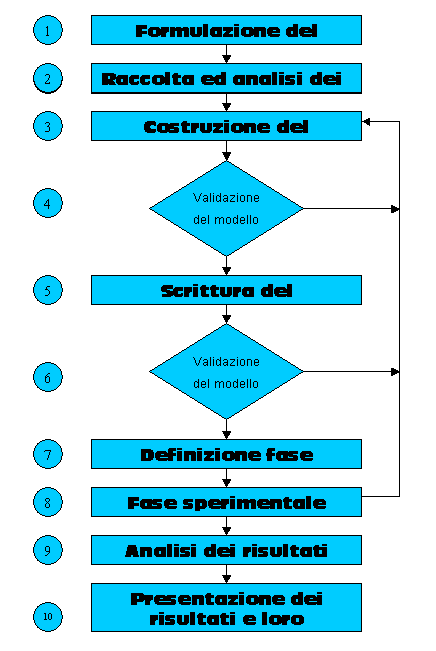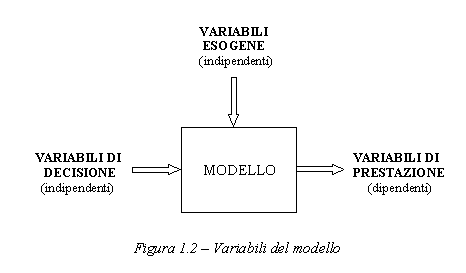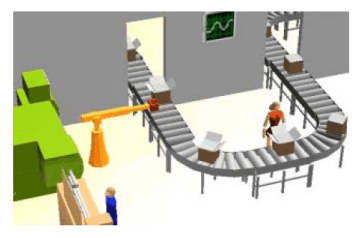1.3 It is made of the simulation
The operations of coding necessary in order to construct a model go framed in a process of study of
the system that follows various steps.
This process is not a simple sequence is made, in fact it is necessary to return to the previous step every time that
more and more acquires acquaintances deepened on the system.
The process of study of the system can be subdivided in following is made:
- Formulation of the problem:it comes defined the system to study and its it objects to you.
- Collection given:quantitative observations and data are collected you on the system.
- Construction of the model:they are formulated of the hypotheses and the model is constructed.
- Validazione:account of data more and more deepened is necessary to confront the characteristics of the model with those of the system being held in order to make to increase the credibility of the model.
- Construction of the program:the program in a generic language or of simulation is written. The employment of a simulator user-friendly can simplify very this activity regarding uses it of a generic language of programming.
- Validazione:they are carried out of the pilot run in order to see if the output of the model they are approached output of a already existing system having same characteristics of the model. If the output they are not in agreement then they modify the hypotheses and the same model.
- Definition phase experiences them:the optimal values of the time of simulation must be established, of the conditions begin them, of the necessary warm-up period, and number of run of simulation.
- Phase experiences them:the run are carried out of simulation.
- Analysis of turns out to you:they come elaborates turns out to you to you using the techniques of statics in order to construct intervals of confidenza for the measures of the performances of the system.
- Presentation of turns out to you and they implementation.

Fig. 1.1- Flow chart of simulation
I use of simulation techniques is involved normally three types of variable that characterize the operation of the considered
system:
- variable of decision:they regard the choices of the planner in the within of the progettuali alternatives available as far as the adopted configuration of the system and operating political;
- variable of performance:they regard the parameters uses you as indices of the performances supplied from the system;
- variable exogenous or ties:they regard the limitations taxes from the planner, is for how much concerns the configuration of the system that the previewed operating conditions for its operation.
The simulation program supplies, for every iterance, a series of relative observations to the variable ones of performance
(variable employee) in correspondence of assigns exogenous values to you of the variable ones of decision and variable (variable
the independent ones) and moreover the continuous monitoring of their course concurs, like represented in figure 1.1.
 Elements that characterizes the logical structure of a stocastico model of simulation to discreet events of dynamic type
- that it is equivalent more to the model adapted for the logistic-productive systems analysis - is:
Elements that characterizes the logical structure of a stocastico model of simulation to discreet events of dynamic type
- that it is equivalent more to the model adapted for the logistic-productive systems analysis - is:
- ENTITA': objects or persons in transit through the system (es. pieces in working or enlivened cargo units);
- IT BLOTS some:members of the system who in transit carry out detailed lists activity on the entities and all the resources that distribute a whichever service in the simulated system (es. means of production or movimentazione);
- STATES:the variable ones of state of the system are with of variable numerical and logical that contains all the information necessary to describe the situation of the same system in every moment of time;
- ATTRIBUTES:variable permanent (numerical or the logical ones) that they stablily characterize the relative largenesses to the entities or the resources of the system.
- ATTIVITA':operations carried out from in transit blot of it on the entities (as an example those of transformation or movimentazione). To ciascuna activity a duration is associated, of determinist or stocastico type, famous at the beginnig of the same activity (the delay of an entity in a tail is not an activity in how much does not have a famous duration but it depends taking place itself of sure conditions).
- TAILS:with of entity in wait approaching detailed lists it blots some according to defined priority rules.
- EVENT:instantaneous to take place of a phenomenon that modification the state of the system. As an example the withdrawal of money of an entity from a wait tail constitutes an event, is because the warehouse comes to contain a smaller number of parts, is because modification the general situation of the system. In correspondence of the events changes in the variable ones are produced of state.
- OPERATIONS:they are the activities carried out from blots some (is made active) and provoked taking place itself of determines events to you.
The operations can be:
- immediate:they achieve immediately to taking place itself of an event;
- you condition:they can only happen if determined conditions are satisfied.
- SIMULATION CLOCK:it is the element that supplies the time simulation current. Naturally not there is some relation between the time of simulation and the time necessary in order to carry out a run of simulation on the calculating.
 Taking for example an assemblage system, the entities correspond to the products in phase of completion that journey
through the job stations; to every type of entity attribute corresponds an assigned cycle of assemblage ();
it blots some correspond to the job stations that carry out assemblage operations (activity) with various durations
to second of the type of product; it blots some can be found in the occupied state of free or of;
the tails correspond to the buffer of accumulate of the products in wait to approach the stations that are found momentarily
to the occupied state of.
Taking for example an assemblage system, the entities correspond to the products in phase of completion that journey
through the job stations; to every type of entity attribute corresponds an assigned cycle of assemblage ();
it blots some correspond to the job stations that carry out assemblage operations (activity) with various durations
to second of the type of product; it blots some can be found in the occupied state of free or of;
the tails correspond to the buffer of accumulate of the products in wait to approach the stations that are found momentarily
to the occupied state of.


